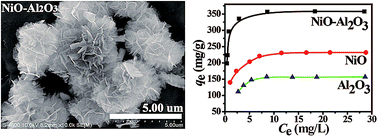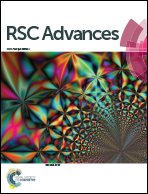Hierarchically porous NiO–Al2O3 nanocomposite with enhanced Congo red adsorption in water
Abstract
Congo red (CR) has been widely used in the textile industry. However, the discharge of wastewater containing CR is a subject of great concern with regard to environmental protection. Herein, NiO, Al2O3, and NiO–Al2O3 nanocomposite adsorbents with hierarchical porous structures were prepared by a simple solvothermal method. Adsorption removal of CR dye from aqueous solutions was investigated using the prepared samples as adsorbent, which had hierarchical porous structures composed of mesopores (2–50 nm) and macropores (>50 nm). The equilibrium adsorption data of CR on the NiO–Al2O3 samples were well fitted by the Langmuir model and yielded a maximum adsorption amount of 357 mg g−1, which was higher than that of NiO and Al2O3 samples. The high adsorption of the NiO–Al2O3 nanocomposite sample was caused by the synergic effect of its hierarchical porous structures, high specific surface area, and positive surface charge at pH 7. Adsorption kinetic data could be well fitted by the pseudo-second-order kinetic equation, suggesting that pseudo-second-order kinetics could well represent the adsorption kinetics of the NiO–Al2O3 samples. The calculated activation energy needed by NiO–Al2O3 samples to adsorb CR indicated that the adsorption of CR molecules on NiO–Al2O3 sample was facilitated by physical adsorption process.


 Please wait while we load your content...
Please wait while we load your content...